Judi Lynn
Judi Lynn's JournalDrugs, aliens and psychedelia: When a cult possessed Brazil's greatest musician
After flicking through an outlandish manifesto under the influence of mescaline, Tim Maia embarked on a frenzied period of divinely inspired artistry, writes Jake Cudsi
11 hours ago
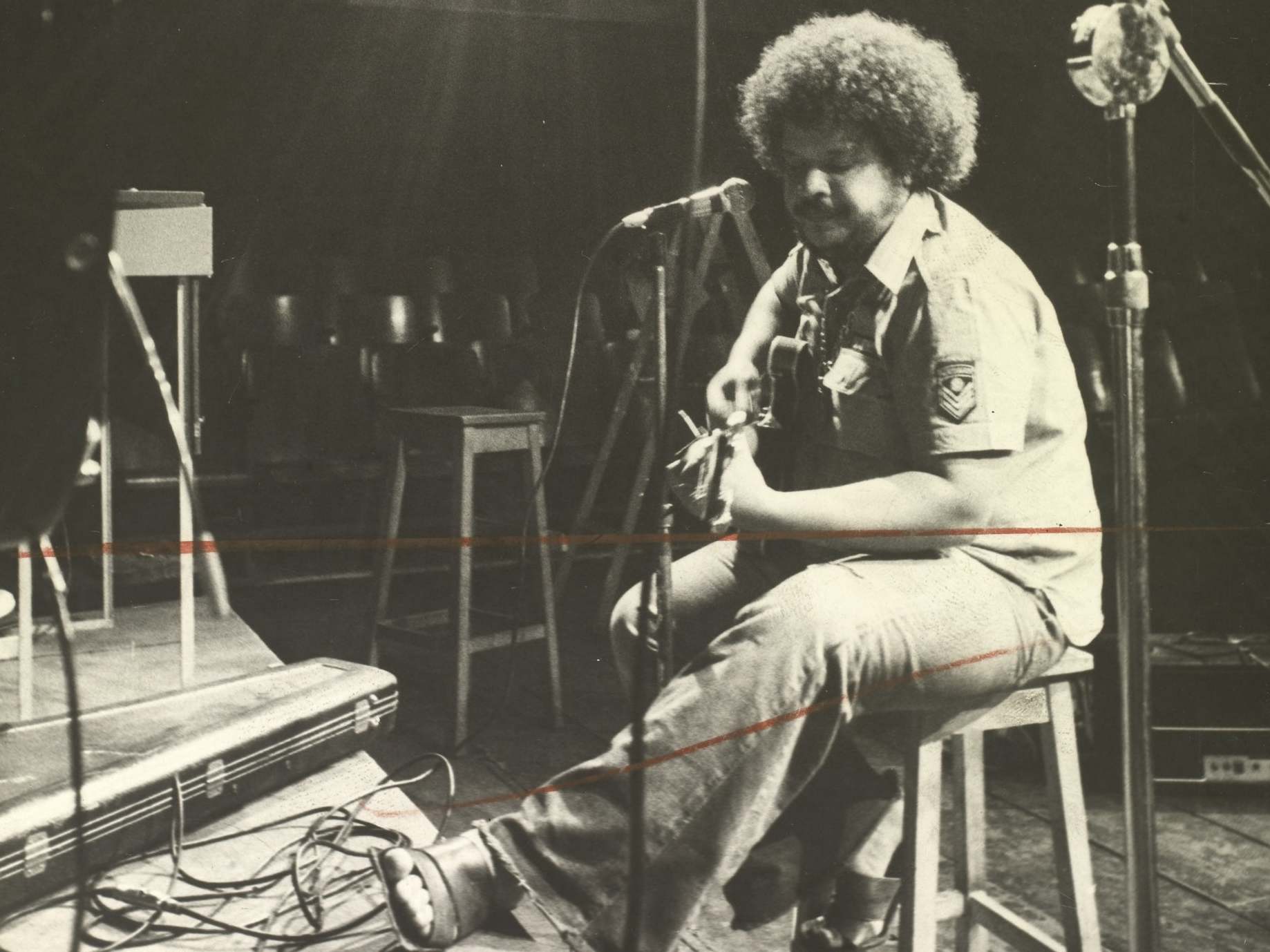
Tim Maia had already lived a storied existence by the time he picked up a book laying down the doctrines of “Rational Culture”. One of Brazil’s greatest living artists, he found the manifesto in his friend Tiberio Gaspar’s house, flicking through it under the influence of some mescaline he’d taken. By mid-1975, Maia had converted to a cult, and was producing audio propaganda at a rate of knots.
. . .
Before the events of 1974, he’d garnered a reputation as the foremost Afro-Brazilian artist working in the country, constantly developing new sounds, blending the influence of American rock and more traditional Brazilian pop, samba and baiao.
. . .
But, as would be the case so often in his career, Maia was just ahead of the times. Eventually, fellow artists and producers cottoned onto the sound he was pushing, helping secure a record deal and push Maia into the mainstream. His 1970 debut album Tim Maia spent 24 weeks at the top of the charts.
. . .
. . .
His devotion to the cult wasn’t just limited to making great music, though. According to the journalist Nelson Motta, Maia would send copies of Universe in Disenchantment (in its original Portuguese) to other famous musicians. These included John Lennon, who reportedly responded with a note reading: “Dear freak, I don’t understand Portuguese”, accompanied by a picture of Lennon stark naked.
. . .
Maia went on to have a hugely successful career, being a trailblazer, a radical, a rebel and becoming one of the icons he had always pushed against, stretching the limits and restrictions of traditional Brazilian music into new, unfamiliar territory.
More:
https://www.independent.co.uk/independentpremium/tim-maia-brazil-cult-rational-culture-universe-in-disenchantment-book-a9421066.html


500 years after initial extermination, native Colombians facing latest foreign virus threat
by Adriaan Alsema March 27, 2020

Wayuu representative Martha Peralta (Image: Twitter)
Native Colombians on Thursday raised the alarm over the first reports of the coronavirus, and a lack of water and access to healthcare.
National indigenous organization ONIC said Thursday that the first cases were confirmed in the Yukpa community on the Venezuelan border.
Viruses coming from abroad are a particularly sensitive issue for the native Colombians considering the fact that diseases brought to the Americas by Europeans all but exterminated the indigenous within decades.
Five hundred years later, the situation hasn’t improved much as many indigenous communities who have been pushed back into the peripheries of Colombia are unable to protect themselves.
More:
https://colombiareports.com/500-years-after-virtual-extermination-native-colombians-facing-latest-foreign-virus-threat/
Well worth the time reading, for anyone unacquainted with ancient (3,000 B.C.) S.American societies.
I just stumbled across this and have to share it with anyone who hasn't read much on Andean prehistoric complex cultures in the Americans which have ALWAYS been ignored in general by general U.S. American interest:
Norte Chico civilization
The Norte Chico civilization (also Caral or Caral-Supe civilization)[NB 1] was a complex pre-Columbian-era society that included as many as thirty major population centers in what is now the Norte Chico region of north-central coastal Peru. The civilization flourished between the fourth and second millennia BC, with the formation of the first city generally dated to around 3500 BC, at Huaricanga, in the Fortaleza area.[1] It is from 3100 BC onward that large-scale human settlement and communal construction become clearly apparent,[2] which lasted until a period of decline around 1800 BC.[3] Since the early 21st century, it has been established as the oldest-known civilization in the Americas.
This civilization flourished along three rivers, the Fortaleza, the Pativilca, and the Supe. These river valleys each have large clusters of sites. Further south, there are several associated sites along the Huaura River.[4] The alternative name, Caral-Supe, is derived from the city of Caral[5] in the Supe Valley, a large and well-studied Norte Chico site. Complex society in Norte Chico arose a millennium after Sumer in Mesopotamia, was contemporaneous with the Egyptian pyramids, and predated the Mesoamerican Olmec by nearly two millennia.
In archaeological nomenclature, Norte Chico is a pre-ceramic culture of the pre-Columbian Late Archaic; it completely lacked ceramics and apparently had almost no visual art. The most impressive achievement of the civilization was its monumental architecture, including large earthwork platform mounds and sunken circular plazas. Archaeological evidence suggests use of textile technology and, possibly, the worship of common god symbols, both of which recur in pre-Columbian Andean cultures. Sophisticated government is assumed to have been required to manage the ancient Norte Chico. Questions remain over its organization, particularly the influence of food resources on politics.
Archaeologists have been aware of ancient sites in the area since at least the 1940s; early work occurred at Aspero on the coast, a site identified as early as 1905,[6] and later at Caral further inland. In the late 1990s, Peruvian archaeologists, led by Ruth Shady, provided the first extensive documentation of the civilization with work at Caral.[7] A 2001 paper in Science, providing a survey of the Caral research,[8] and a 2004 article in Nature, describing fieldwork and radiocarbon dating across a wider area,[2] revealed Norte Chico's full significance and led to widespread interest.[9]
More:
https://en.wikipedia.org/wiki/Norte_Chico_civilization
Remnants of the cultures:
![]()
To Build An Empire, Hold The Anchovies
February 26, 201311:54 AM ET

To Build An Empire, Hold The Anchovies
February 26, 201311:54 AM ET
Megalomaniacs, consider yourselves warned. Anchovies will not help you build your empire. To rule long and prosper, serve corn.
That's the word from archaeologists who say they've solved a mystery that has been puzzling their colleagues for the past 40 years: How did some of the earliest Peruvians manage to build a robust civilization without corn — the crop that fueled other great civilizations of the Americas, like the Maya?
The Norte Chico people, who lived some 5,000 years ago, built a thriving civilization — but from the archaeological evidence previously available, it looked like they did it solely on anchovies. And anyone who has ever nibbled an anchovy on a pizza knows there's not a lot of meat on those tiny bones.
Would that have given the Norte Chico enough oomph to build the monumental architecture they left behind, including dozens of large communities with huge earthen platforms and circular ceremonial plazas, some 40 meters across?
More:
https://www.npr.org/sections/thesalt/2013/02/25/172896292/to-build-an-empire-hold-the-anchovies
~ ~ ~
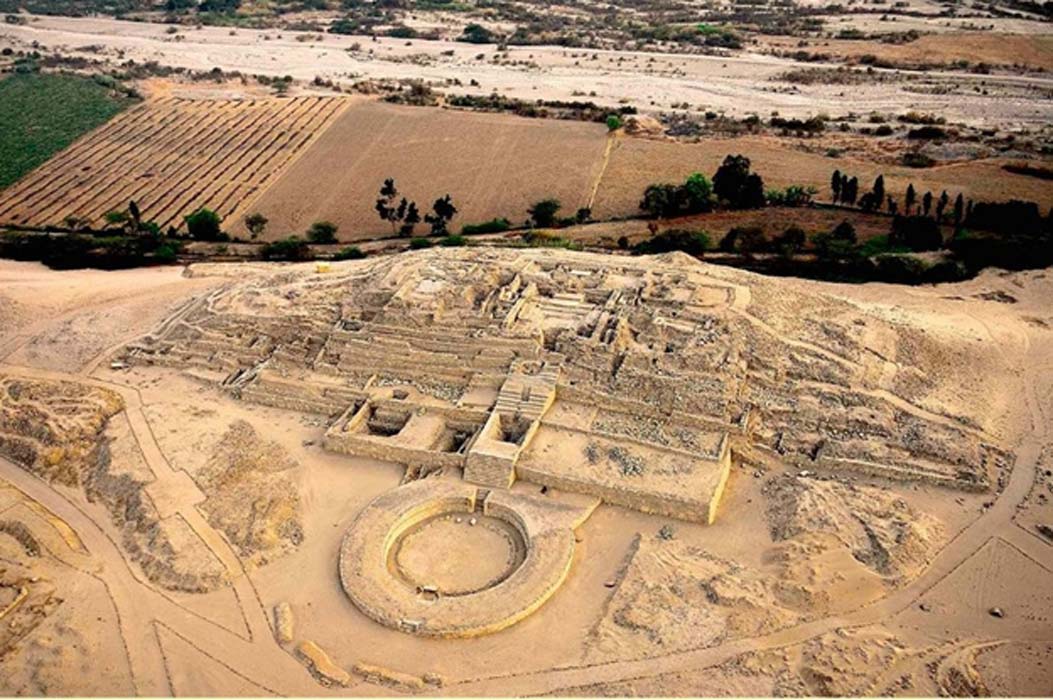
9 JULY, 2019 - 17:25 DHWTY
Norte Chico: The First Civilization in the Americas?
The Norte Chico Civilization was an ancient civilization/complex society belonging to the Pre-Columbian era. This civilization flourished in Peru about 5000 years ago, and is believed to be the oldest known civilization to have existed in the Americas.
The Norte Chico Civilization is notable today for its monumental constructions, including massive ceremonial pyramids and complex irrigation systems. This ancient civilization lasted until around 1800 BC, after which the settlements were abandoned.
Located north of Lima, Peru, the Caral-Supe settlement was the ancient home of the Norte Chico people, a civilization almost as old as the Egyptians.
Courtesy of Chris Kleihege
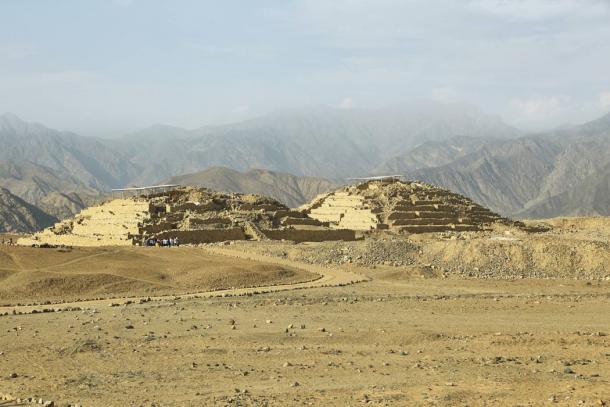
Pyramids at Caral, Supe Valley, Peru. ( estivillml /Adobe Stock) The complexity of the Norte
Chico Civilization may be seen in the monumental works that they left behind, especially
their ceremonial pyramids.
Location of Norte Chico Civilization Sites
The sites of the Norte Chico Civilization are situated around 200 km (124.27 miles) to the north of Lima, in what is today the Norte Chico region of north-central coastal Peru, near Supe, Barranca province. This civilization is also known as the Caral / Caral-Supe Civilization, as its best-studied site is Caral in the Supe Valley.
Based on radiocarbon dating, it has been suggested that the formative period of the Norte Chico Civilization was sometime during the 4th millennium BC. The civilization’s greatest period of expansion, however, belongs to the 3rd millennium BC.
The dating of the Norte Chico Civilization shows that these inland sites were developing around the same time as their coastal neighbors. This is important, as it challenges the conventional view that all early civilizations in Peru and the rest of South America began by the sea as coastal settlements.
However, a close inter-dependent relationship between the peoples of the coast and the Norte Chico Civilization also existed. Trade is believed to have been based on fish from the coast being exchanged for cotton (for the production of fishing nets) from the interior.
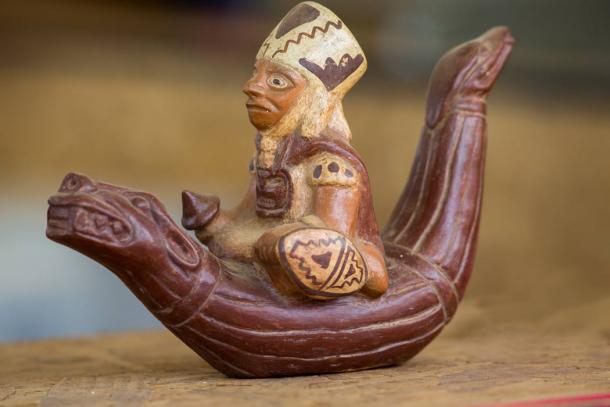
More:
https://www.ancient-origins.net/ancient-places-americas/norte-chico-civilization-ancient-peruvian-civilization-or-complex-society-021445
~ ~ ~
Neighbouring city of ancient Caral at risk
March 23rd, 2010
Authorities from the local district of Barranca are investigating reports that part of Era de Pando, the ruins of a city belonging to the civilisation that built the nearby capital of Caral, have been occupied by local farmers with the intent of destroying a pyramid to build a reservoir to water the crops they are planting in the ancient site’s plaza.
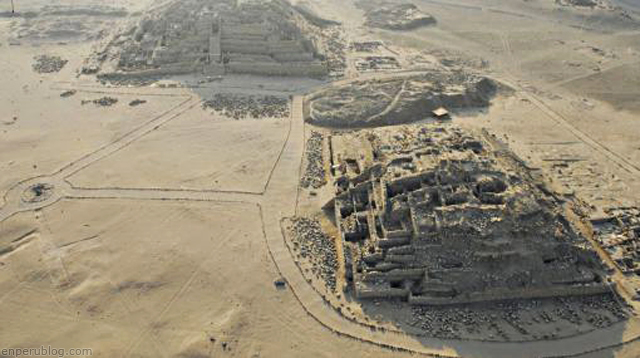
Just one month ago archaeologists had attempted to work in the area but were threatened with hostility by the illegal occupiers, forcing them to request protection from an as yet unresponsive police service.
The association of farmers defended their actions and intentions by stating they had acquired ownership of the land and have deeds. Authorities contest however that the archaeological site was declared national heritage in 2000, a time when there were no occupiers.
. . .
Archaeological Terrorism
Caral is not the only site under threat by illegal occupiers. The most vicious have been squatters at the Bosque de Pomac site, who are formed by heavily-armed violent locals who kill endangered species, burn down some of the last remaining tracts of dry forest, dig holes in pyramids and murder police officers attempting to enforce the law.
The site is located in the lower half of the Supe valley on the northern side of the river and at the mouth of a dry dusty gully just metres above the fertile valley floor. Its size and distribution tell us it was an urban settlement rather than any type of ceremonial centre.
Authorities, who will inspect the site tomorrow at 10am, state that other archaeological sites in the valley are also under threat. The similarly aged site of Lurihuasi is being built upon with
http://enperublog.com/2010/03/23/neighbouring-city-of-ancient-caral-at-risk/
~ ~ ~
Discover Ancient Caral – The City That Time (almost) Forgot
15 Jul, 2016
A hidden UNESCO treasure only a few hours out of Lima, Caral is an ancient citadel which predates the Incas by 4,000 years. Time may have forgotten the reputed ‘Oldest City in the New World’ for a while, but it has now rediscovered it with gusto. So come along as we explore what is, thus far, the oldest city ever discovered in the American continent.
The mere mention of ‘great ancient civilizations’ is usually enough to conjure up images of grandiose Roman amphitheatres, flamboyant Chinese dynasties, Egyptian pyramids, and awe-inspiring Greek temples. Yet what many people don’t know, is that one of the oldest civilization of modern man arose from the arid desert sands of modern-day Peru. Caral is the incredible legacy the Norte Chico culture left behind: an archaeological masterpiece which was once a bustling metropolis comprising pyramids, temples, houses, amphitheatres, and ornate plazas. In 2001, UNESCO named Caral ‘the oldest city in the Americas’, almost 1,000 years after the first signs of its existence were detected by famed German archaeologist Max Uhle. Not since 1911, when American Hiram Bingham stumbled upon mystical Machu Picchu, has a more significant discovery emerged from Latin America.
Finally open to the public and set to become one of Latin America’s foremost historical attraction, the Ancient city of Caral is a marvel not to be missed when visiting Peru.
Caral: an unrivalled discovery that boggled the scientific world
Caral wasn’t just built 4,000 years before the revered Inca city of Machu Picchu, it was also built four millennia before the great Khmer Empire’s Angkor Wat, three millennia before the Romans built their colossal Colosseum, and even half a millennia before the mighty ancient Egyptians erected their Pyramids at Giza. This ancient city is so old that no pottery has ever been found there. Ceramic had not even been invented when it was built. The mounds which we now know to be pyramids were for decades thought to be natural forming hills by previous surveyors in the early 1900s, and this is primarily the main reason why the city remained hidden for so long. Moreover, when initial carbon-dating was carried out, it was summarily disregarded. Many thought it preposterous that the site could be 4,500 years old. Well, so much for that theory.
With further testing, Caral turned out to be 500 years older than that still.
Yet it isn’t only the age of the structures at Caral that is utterly impressive. What anthropologists find most fascinating are the in-depth stories the city tells of human kind’s first attempts at creating a centralised tiered society, and developing the credo that working together for a common goal is more prosperous in the long run.
. . .

More:
https://www.chimuadventures.com/blog/2016/07/discover-ancient-caral/
Bolsonaro, a danger to Brazil: 'Staying home is for cowards'
Even O Globo, which played such a large role in his election, said Jair Bolsonaro didn't care about the welfare of Brazilians.
written by Claudia Fanti
Published on
March 28, 2020
The fact that Bolsonaro was a danger to public health was already clear enough, but his latest statements have truly shocked the country. On Tuesday evening, speaking on live TV, while the main cities were ringing out with the deafening noise of the banging of pots and pans in the seventh consecutive panelaço protest, Brazil’s president once again compared the COVID-19 pandemic to a gripezinha, “a little cold,” accusing the press of generating hysteria and calling for a return to “normality.”
“Our lives must move forward,” he said, demanding that the governors should “abandon the concept of scorched earth,” by which he meant the shutdown of commercial activities and “mass confinement.” He rejected out of hand any comparison with Italy, which he dismissed as a “country of old people,” and also spoke out against the closure of schools: “The group at risk are people over the age of 60. So why suspend classes, then?”
On Wednesday morning, heedless of the deluge of indignant reactions pouring in, the Brazilian president, whom the well-known American political scientist Ian Arthur Bremmer has called the most inefficient head of state in the world in the fight against the pandemic, doubled down as usual, announcing his intention to ask the Minister of Health, Luiz Henrique Mandetta, to adopt a policy of nothing more than “vertical isolation,” i.e. isolation limited exclusively to the elderly or people suffering from other diseases, and calling the quarantine measures enacted by the governors of Rio and São Paulo, Wilson Witzel and João Doria, “a crime.” And that wasn’t all: in absolute opposition to the rest of the world, he went as far as to say that “staying at home is for cowards.”
The backlash from these statements could not have been stronger. Even the newspaper O Globo, which contributed so much to his election, pulled no punches: for Bolsonaro, the main editorial reads, “the welfare of Brazilians is of no importance at all, most of them low-income and often living in favelas or communities vulnerable to the coronavirus, dependent on the action of a government whose president insists on minimizing the crisis.”
More:
https://global.ilmanifesto.it/bolsonaro-a-danger-to-brazil-staying-home-is-for-cowards/
'Mafia planning to assassinate journalists who revealed ties between narco and Colombia's ruling par
‘Mafia planning to assassinate journalists who revealed ties between narco and Colombia’s ruling party’
by Adriaan Alsema March 21, 2020
Colombia’s mafia is allegedly planning the assassination of three journalists who revealed that the country’s ruling elite conspired with narcos to rig the 2018 elections in favor of President Ivan Duque.
Press freedom foundation FLIP sent out an alert after a senator shared evidence that members of criminal organizations met on Saturday last week to plot the assassination of journalists Gonzalo Guillen, Daniel Mendoza and Diana Lopez.
The audio additionally revealed a plot to assassinate Beto Coral, a popular pundit on Twitter who has frequently clashed with Uribe over evidence the former president has been in bed with the mafia since the 1980s.
. . .
Despite the “imminent threat” of assassination, the National Protection Unit (UNP) has refused to provide protection to the journalists who published the evidence of Duque’s far-right Democratic Center party’s ties to the organization of jailed drug trafficker Marquitos Figueroa.
More:
https://colombiareports.com/mafia-planning-to-assassinate-journalists-who-revealed-ties-between-narco-and-colombias-ruling-party/
Killing Colombia's human rights defenders has never been this easy
by Adriaan Alsema March 27, 2020
. . .
Fearing that quarantine measures in place to contain the spread of the coronavirus could trigger an increase in assassinations, multiple international human rights and religious organizations asked the government of President Ivan Duque to step up protection measures on Wednesday.
With most people inside their homes, no witnesses on the street and police trying to enforce the quarantine, social leaders are feared to be more vulnerable than ever.
A new wave of killings
Less than 24 hours after the organizations sent the open letter, two indigenous leaders and one women’s rights defender were assassinated and one gay rights defender survived an assassination attack in Medellin, the country’s second largest city.
Since March 19, when governors and mayors decreed curfews and quarantine drills in their territories, six human rights defenders have been killed.
More:
https://colombiareports.com/killing-colombias-human-rights-defenders-has-never-been-this-easy/
Also posted in Editorials and other articles:
https://www.democraticunderground.com/1016250521
An ancient ball court sheds light on a game made famous by the Aztecs
A mountain site in Mexico suggests an ancient ball game didn’t originate in coastal lowlands
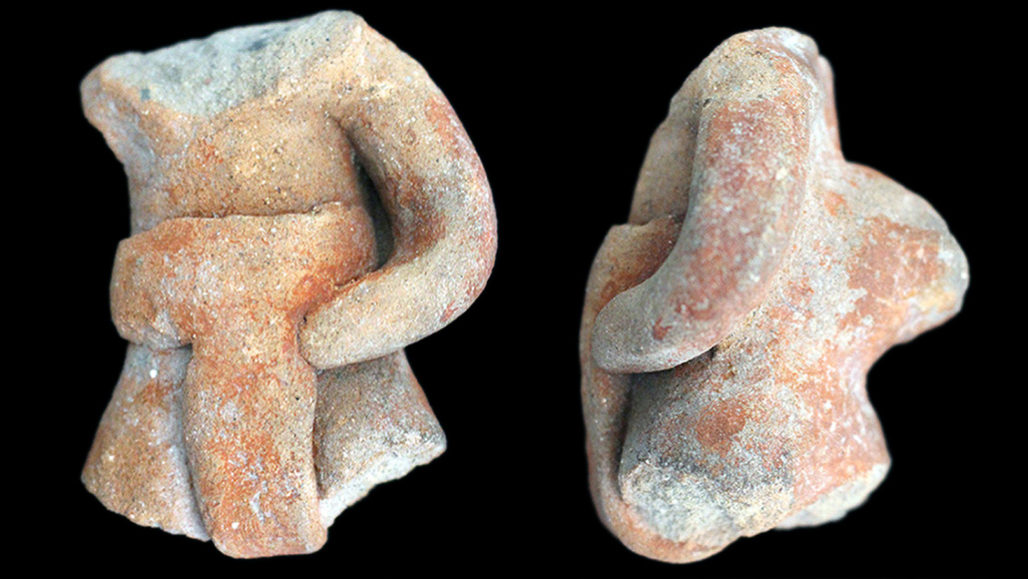
Partial ballplayer figurines such as this (shown from the front and side) were unearthed at a mountain site in southern Mexico that also contained a ball court from around 3,400 years ago.
J. BLOMSTER AND V. SALAZAR CHÁVEZ/SCIENCE ADVANCES 2020
By Bruce Bower
MARCH 13, 2020 AT 2:00 PM
A roughly 3,400-year-old ball court in the mountains of southern Mexico has scored surprising insights into a game that later played a big role in Maya and Aztec societies.
Excavations at a site called Etlatongo revealed the ancient ball court — the second oldest found to date. The discovery shows that, at a time when societies in Mexico and Central America were growing larger and more politically complex, population centers in the mountains contributed to ball court design, and possibly to early rules of the game, researchers report March 13 in Science Advances.
Until now, most evidence pointed to coastal settlements in southern Mexico’s Gulf and Pacific lowlands as the developers of a ball game that assumed ritual and political importance throughout the region.
“Multiple regions and societies were involved in developing a blueprint for the ball court used in a formal ball game across Mesoamerica,” says anthropological archaeologist Jeffrey Blomster of George Washington University in Washington, D.C. Mesoamerica was an ancient cultural region running from central Mexico through much of Central America.
More:
https://www.sciencenews.org/article/ancient-ball-court-aztecs-maya-society
3,400-year-old Mesoamerican ball court sheds light on origins of the game
The site suggests highland communities played a role in developing the game.
KIONA N. SMITH - 3/25/2020, 9:23 AM
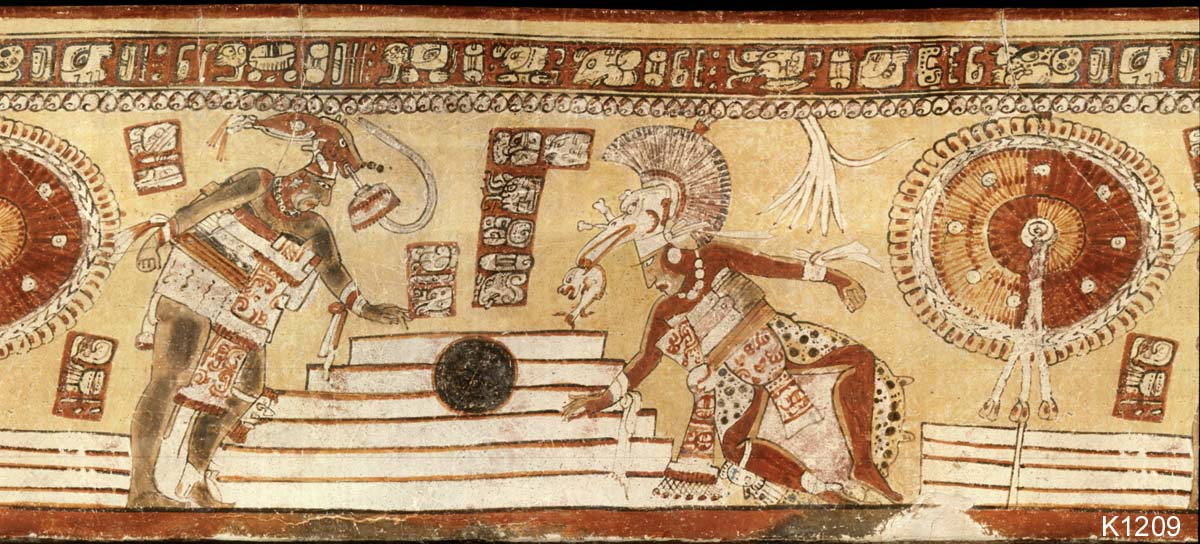
Millennia ago, a stone court would have hosted teams of players wearing belts and loincloths using their hips to knock a hard rubber ball toward goals at either end of the court. The ball game, which re-enacted a creation story recorded in the Maya religious text Popul Vuh, was a major part of political, religious, and social life for the Maya and the Aztec, and for the Olmec before them. But archaeologists don’t yet know much about where people first started playing the game or how it became a cultural phenomenon that spread across the area that now includes Guatemala, Belize, Mexico, Honduras, and El Salvador.
Layers of ball courts
The ball court—a stone-floored alley about 50 meters (165 feet) long, bounded by steep stone walls and earthen mounds—once occupied a place of honor in the heart of the ancient city. But sometime between 1174 and 1102 BCE, the people of Etlatongo dismantled parts of the court and ritually “terminated” its life. That ceremony left burned bits of plant, mingled with broken Olmec-style pottery, animal bones, shells, and a few human bones (which may or may not have come from a later cemetery) scattered on the carved bedrock floor of the court and atop the earthen mounds that ran the length of its sides.
But beneath that 12th century BCE ball court lay another, even older one, dating to 1374 BCE. That's roughly when (as far as archaeologists can tell from the available evidence) the formal version of the game—the one played on elaborate stone courts for crowds of wealthy, high-ranking spectators in major urban centers—was still being developed. Archaeologists Jeffrey Blomster and Victor Salazar were surprised to find a ball court so old in the mountainous highlands of Mexico instead of the Olmec-dominated tropical lowlands, where archaeologists have assumed the game got started.
The oldest known Mesoamerican ball court, which dates to 1650 BCE and has a floor of compacted earth rather than stone, is at Paso de la Amada in Chiapas, on the Pacific coast of Mexico just northwest of Guatemala. Until now, it looked like people didn’t start building formal stone ball courts in the Mexican highlands until almost a thousand years later. By then, the game had been fully developed and exported all over Mesoamerica—or so it was widely thought.
More:
https://arstechnica.com/science/2020/03/3400-year-old-mesoamerican-ball-court-sheds-light-on-origins-of-the-game/
Canadian Media Advocate Continued Domination of Indigenous Peoples
MARCH 25, 2020
GREGORY SHUPAK

Canada’s Royal Canadian Mounted Police (RCMP) began raids on the territory of the Wet‘suwet’en Indigenous nation on February 6—arresting as many as 80 Indigenous land defenders in the first days of the incursion—to dismantle camps that the Wet‘suwet’en had established on their land to prevent construction of a $6.6 billion liquid natural gas pipeline being built by Coastal GasLink, which is owned by TC Energy.
The police were enforcing an injunction from the British Columbia (BC) Supreme Court, though the Wet‘suwet’en have never ceded control of their land to Canada. Under Wet‘suwet’en law (Canadian Observer, 2/7/20), hereditary chiefs have authority over their territory. They opposed the pipeline, though it has support from the elected Wet’suwet’en band councils that were created under the Indian Act, which Canada unilaterally imposed on Indigenous peoples in 1876.
Coast-to-coast solidarity actions by Indigenous peoples and their supporters began in response to the RCMP raids, most notably in the form of road, highway and rail blockades, including a shut-down of the country’s principle east-west rail link. Blockades led to significant service halts by VIA Rail, Canada’s main rail passenger rail service, and disruptions in the operations of CN Rail, a major freight railway and the country’s only transcontinental railway.
A pickup truck with a Confederate flag on its dashboard drove through a highway blockade in BC (Global, 2/11/20). In Saskatchewan, a man drove into people blocking a highway (Global, 2/12/20). Indigenous peoples faced a deluge of racism (Al-Jazeera, 3/2/20), including death threats (Al-Jazeera, 3/1/20)
More:
https://fair.org/home/canadian-media-advocate-continued-domination-of-indigenous-peoples/
Cuba's coronavirus response is putting other countries to shame

By Jacobin Last updated Mar 25, 2020
By Ben Burgis / From Jacobin
Last week, the MS Braemar, a transatlantic cruise ship carrying 682 passengers from the United Kingdom, found itself momentarily stranded. Five of the cruise’s passengers had tested positive for the coronavirus. Several dozen more passengers and crew members were in isolation after exhibiting flu-like symptoms. The ship had been rebuffed from several ports of entry throughout the Caribbean. According to sources in the British government who spoke to CNN, the UK then reached out to both the United States and Cuba “to find a suitable port for the Braemar.”
Which country took them in? If you’ve paid attention to the Trump administration’s xenophobic rhetoric about “the Chinese virus” and its obsession with keeping foreign nationals out of the country, and you know anything about Cuba’s tradition of sending doctors to help with humanitarian crises all around the world, you should be able to guess the answer.
The Braemar docked in the Cuban port of Mariel last Wednesday. Passengers who were healthy enough to travel to their home countries were transported to the airport in Havana. Those who were too sick to fly were offered treatment at Cuban hospitals — even though there had only been ten confirmed cases in the whole country, and allowing patients from the cruise ship to stay threatened to increase the number.
Cuba Mobilizes Against the Virus
Despite being a poor country that often experiences shortages — a product of both the economy’s structural flaws and the effects of sixty years of economic embargo by its largest natural trading partner — Cuba was better positioned than most to deal with the coronavirus pandemic.
More:
https://progresoweekly.us/cubas-coronavirus-response-is-putting-other-countries-to-shame/
Profile Information
Member since: 2002Number of posts: 160,515